We explore Adolf Hitler, his life and childhood. In addition, we discuss his general characteristics and ideas.

Who was Adolf Hitler?
Adolf Hitler was an Austrian-born military officer and politician who spearheaded Nazism in Germany. He was appointed Chancellor of Germany in 1933 and was one of the key political figures during World War II (1939-1945). He was born on April 20, 1889, in Braunau am Inn, in the former Austro-Hungarian Empire.
A frustrated painter, he dedicated his life to politics. He had a relationship and married Eva Braun, who was twenty-three years his junior. Hitler had no children. He was called “the Führer,” which means chief or leader in German.
In his early military career, he participated in World War I (1914-1918), where he attained the rank of corporal. He was highly critical of the Treaty of Versailles (1919), which imposed severe war reparations on Germany, and led the National Socialist German Workers' Party, more commonly known as the Nazi Party.
Hitler aspired to establish absolute German hegemony over Europe, one of the central ideas of his political and military activity rooted in the belief of the superiority of the "Aryan race". This led to the outbreak of World War II and the slaughter of millions of people, especially European Jews, in extermination camps.
Adolf Hitler committed suicide alongside Eva Braun on April 30, 1945, in his Berlin bunker, as Soviet troops entered the capital and Germany's defeat in World War II was imminent. Thereafter, rumors circulated casting doubt on Hitler’s suicide, suggesting he would have escaped to an unknown destination.
However, available records make it possible to ascertain that the corpses of Hitler and Braun were in fact burned and buried and that, in 1970, the Soviets exhumed and re-burned the remains before throwing the ashes into a river.
- See also: Francisco Franco
Early years of Adolf Hitler
Childhood and adolescence of Hitler

Hitler was born in a village in Upper Austria, close to the German border. He was the fourth child of Alois Hitler and Klara Pölzl, Alois' third wife. In later life, Adolf Hitler recounted that his father used to whip him as a child. Allegedly, Alois would have had a drinking problem.
The Hitler family moved frequently. Adolf was a good student in elementary school, but repeated the sixth grade. The pan-Germanic ideas of his history teacher, Leopold Pötsch, would influence his later ideology. At the age of sixteen, he dropped out of high school without obtaining his diploma.
He later tried to enter the Academy of Fine Arts Vienna, aspiring to become a painter, but was rejected for "lack of talent". During his stay in Vienna, his political and military ideas, as well as his antisemitism, began to shape Hitler's future personality.
He did not do military service at the age of 21 because he did not want to serve in the Austro-Hungarian Empire alongside Jewish conscripts. At 24, he inherited the estate left to him by his father, who had died in 1903, before moving to Munich, Germany. In January 1914, he was found by the Austrian authorities and was conscripted for military service, but he was eventually deemed unfit.
Hitler during World War I

Hitler participated in World War I as a volunteer in the Bavarian Regiment of the German Army. In 1916, he was wounded in the leg, attaining the rank of corporal. Throughout the war, he was awarded the Iron Cross twice, a decoration for military merit.
In October 1918, he was temporarily blinded by a mustard gas attack. When Germany lost the war on November 11, 1918, Hitler was devastated and, according to his own testimony, he experienced a second episode of temporary blindness.
In 1919, the German government of the Weimar Republic was forced to sign the Treaty of Versailles with the victorious powers, which held Germany responsible for the war and imposed costly war reparations. Hitler shared the critical view of many Germans regarding the Treaty of Versailles, which they referred to as the “diktat” (the imposition). During the interwar period, he accused the government and Social Democrats of having betrayed the German people.
When World War I ended, Germany was in a state of great political and social instability. Adding to the economic difficulties were strikes and uprisings, such as the one led by the Spartacist League in 1919, which fueled the idea of a communist threat among nationalist sectors.
Hitler's entry into politics
Hitler's first political involvement was as a spy within his own army, where he was tasked with informing on comrades who had collaborated with the Soviet government when the short-lived Bavarian Soviet Republic was formed in 1919.
Hitler later joined the German Workers' Party (DAP, German acronym), of a nationalist and anti-communist ideology. A year later, in 1920, the party changed its name to the National Socialist German Workers' Party (NSDAP), also known as the Nazi Party. Hitler became the leader of the party in 1921.
In November 1923, Hitler led the "Munich Putsch", a failed coup d'état that resulted in his imprisonment. While in prison, he began writing his 1925 book Mein Kampf (My Struggle), in which he compiled his political ideas and expounded his antisemitic beliefs.
In My Struggle, Hitler also envisioned his views of German foreign policy. An alliance with the United Kingdom, whose empire he saw as a symbol of the superiority of the Germanic race, and with Italy, where Benito Mussolini, whom he admired, was in power, would serve to confront Germany's traditional enemy: France. The vast territories of Eastern Europe and the Soviet Union (USSR) would serve as an expansion territory or Lebensraum (“living space”) for the German people.
Adolf Hitler and Nazi Germany
The Great Depression and Hitler's rise to power
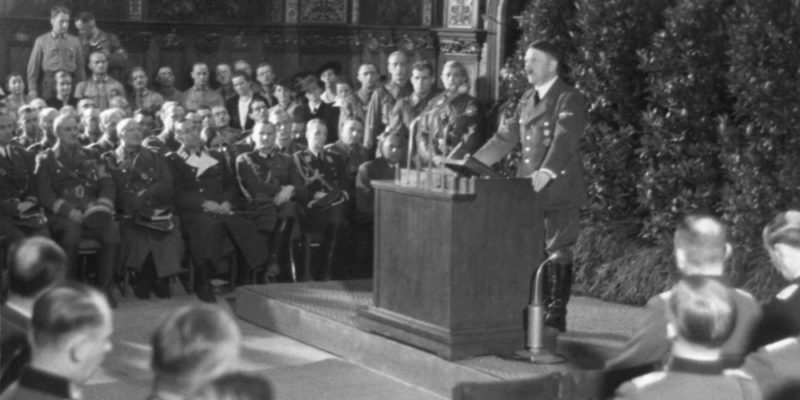
Hitler's political rise coincided with the Great Depression, which began in 1929 in the United States and affected most of the world's economies throughout the 1930s. In Germany, the economic crisis caused difficulties in accessing American loans, and led to rising unemployment.
The severe economic situation and the fear of the growth of communism among some sectors of the population allowed Hitler to gain followers within society, politics, and the armed forces. Moreover, he drew the support from wealthy individuals who financed his party, in the hope of Germany's recovery.
In 1932, presidential elections were held in Germany, in which Adolf Hitler ran as candidate. Paul von Hindenburg, president of Germany since 1925, ran again despite his advanced age, opposing the ideas held by Nazism.
Hitler came in second in the election, and Hindenburg was reelected. However, in the July 1932 legislative elections, the Nazi Party garnered the largest number of votes, winning 230 seats in the Reichstag, the German parliament. Nazism became the largest political force in Germany, and on January 30, 1933, Hitler was appointed chancellor by President Hindenburg.
On February 27, 1933, the Reichstag building in Berlin was set on fire, and Hitler's government accused the communists, persuading Hindenburg to sign an emergency decree suspending several constitutional guarantees under the excuse of fighting against communism.
Upon Hindenburg’s death in 1934, Hitler gained absolute power, supported by a large majority of the German population who saw him as a savior. Thus, the totalitarian regime usually known as Nazi Germany or Third Reich was established.
The Third Reich and the beginnings of German expansion
Starting in 1933, Hitler carried out an expansionist international policy aimed at destroying the order imposed by the Treaty of Versailles. In 1933, he withdrew from the League of Nations and initiated German rearmament.
In 1935, he reinstated compulsory military service and, in 1936, after remilitarizing the Rhineland, he intervened alongside Mussolini in the Spanish Civil War (1936-1939). This collaboration led to the formation of the Rome-Berlin Axis in October 1936, before Germany signed the Anti-Comintern Pact with the Empire of Japan in November 1936.
Hitler took advantage of the appeasement policies of Western Europe democracies (particularly the United Kingdom and France) and starting in 1937, he introduced an expansionist policy. In 1938, he achieved the long-sought “Anschluss” (the German annexation of Austria), and through the signing the Munich Agreement, the occupation of the Sudetenland in Czechoslovakia.
The subsequent invasion of Czechoslovakia revealed his expansionist intentions, leading the United Kingdom and France to abandon their appeasement policy.
In view of imminent war, Nazi Germany signed the German-Soviet Non-Aggression Pact (also known as the Ribbentrop-Molotov Pact) in August 1939. Days later, on September 1, 1939, Germany attacked Poland, prompting the United Kingdom and France to declare war on Germany, and thus starting World War II.
Political propaganda and education under Nazism
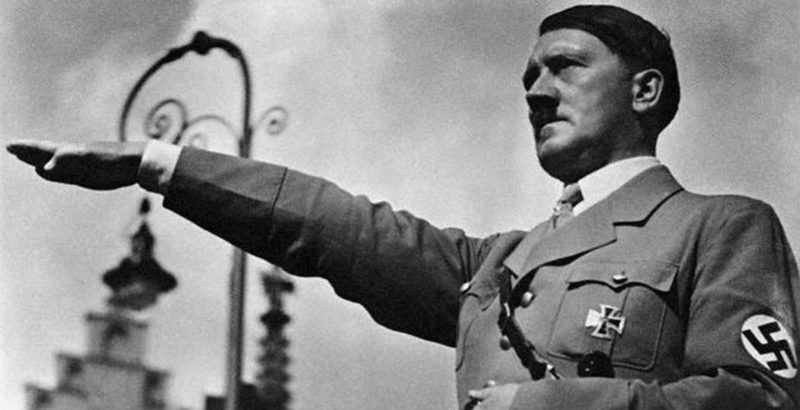
During the Nazi regime of Adolf Hitler in Germany, the media was controlled by the state. Every broadcast and publication was required to pass through censorship, thus eliminating freedom of the press and of opinion.
In addition to making large-scale events and rallies, Hitler was among the first leaders to make use of the new mass media (radio and cinema) for political purposes. The Ministry of Propaganda was charged with this task, led by Joseph Goebbels, one of Hitler's most trusted Nazi officials.
Nazi political propaganda was aimed at communicating the works of Hitler to the German population, presenting him as responsible for the country's progress. In addition, the media was employed to spread antisemitic propaganda and justify discrimination and violence against the Jewish population.
Nazi ideology was also disseminated in education, starting at elementary school and especially so. Hitler believed it was crucial to instill ideas during childhood, and thus win the loyalty of future adults.
Nazi ideology and Hitler's racism
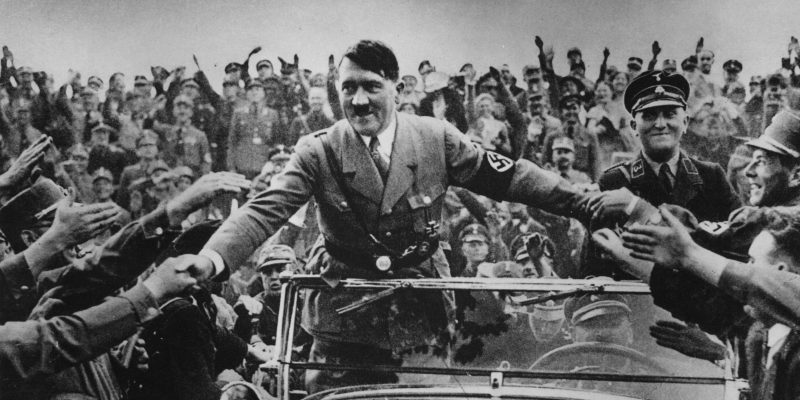
Hitler's hatred of Jews and communists is believed to have begun while living in Vienna. After World War I and following the creation of the National Socialist German Workers' Party, Hitler's rhetoric targeted Jews, communists, and social democrats as responsible for Germany's defeat in the war and the humiliation of the Treaty of Versailles, often referred to as the “stab-in-the-back” myth.
These ideas were connected with what he saw as a historical objective: to gain living space in Eastern Europe (Lebensraum) for German (identified as “Aryan”) settlement, through the expulsion of non-Aryan populations, in order to solve Germany's economic problems.
Hitler's idea to rebuild the German Reich and establish German hegemony in Europe started to shape his political program:
- To rise to power and concentrate state power in his hands and the Nazi Party.
- To nationalize the masses and homogenize the population through the idea of Volksgemeinschaft (“national community”), the harmonious union of all Germans (with the exclusion of those deemed to belong to “inferior races”).
- To overthrow the internal enemy (mainly communists and Jews).
According to some historians, these ideas of Hitler's were initially successful, drawing support from large segments of the population since they expressed the views and prejudices of many postwar Germans.
Hitler's antisemitism was one of the most characteristic features of his ideology. During his regime, concentration camps were established where people were imprisoned based on their ethnic, religious, or political affiliation, including Romani, Slavs, communists, socialists, anarchists and, in particular, Jews.
Hitler believed in a pre-existing myth stating that Jews were plotting a secret conspiracy to take over the world. Furthermore, he blamed German Jews for many of Germany's problems. He held that Jews were an "inferior race" and that Aryans were a "superior race" destined to dominate others, and therefore opposed “racial mixing”.
Hitler's antisemitism spurred acts of discrimination and violence, such as the Law for the Restoration of the Professional Civil Service of 1933 (excluding Jews from public office), and the Night of Broken Glass (attacks against Jews in Germany and Austria in 1938).
The Holocaust or Shoah is the name given to the deportations and confinement in concentration or extermination camps, where the detainees worked in subhuman conditions before being exterminated and thrown into mass graves or simply taken there for annihilation, following the 1942 “Final Solution to the Jewish Question” plan.
Hitler in World War II
Hitler viewed foreign policy as his exclusive domain. His mistrust led him to gradually disregard the services of professional German diplomats.
When World War II broke out between the Axis powers and the Allies, Hitler himself took over the major strategic decisions of the war, often against his generals' advice. Victories in the early years encouraged him to take measures often driven more by ideological stances than by strategic calculations.
Such was the case of the attack on the Soviet Union launched in 1941, which was part of the plan to gain Lebensraum (living space) in the east for German settlement. The assaults on Leningrad and Stalingrad were part of ideological objectives: to conquer cities that were symbols of Bolshevism (especially Stalingrad, named after the Soviet leader, Joseph Stalin). This resulted in a catastrophic defeat at the Battle of Stalingrad, which changed the course of the war.
Another turning point in the war was the entry of the United States into the conflict in 1941. Following the Japanese attack on Pearl Harbor on December 7 and the United States' ensuing declaration of war on Japan, Hitler declared war on the United States on December 11, 1941.
The extermination policy against the Jewish population and the violence deployed by the German army on the Eastern Front were driven by Hitler, who considered the war an opportunity to achieve his racist objectives set forth in My Struggle.
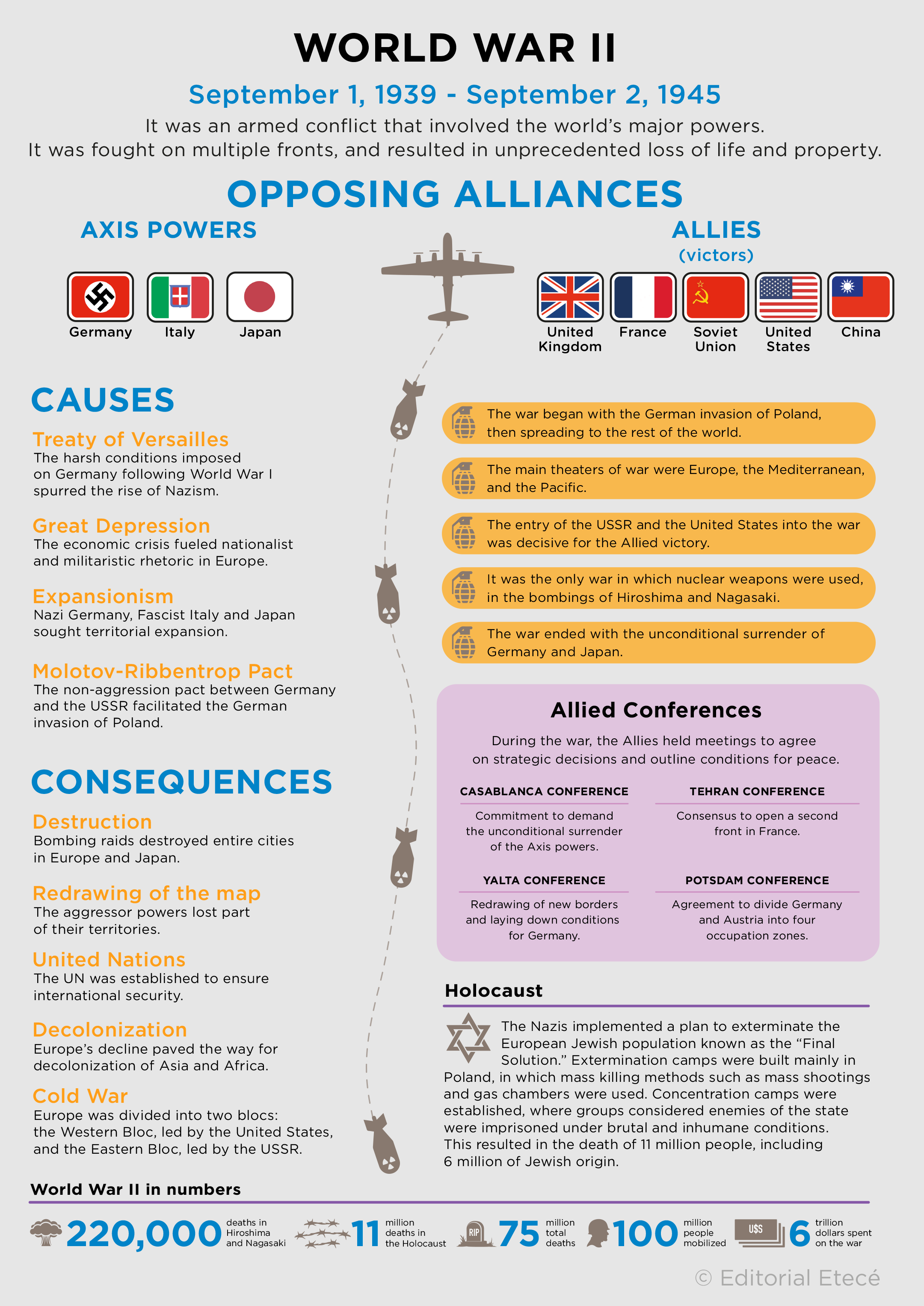
Death of Adolf Hitler
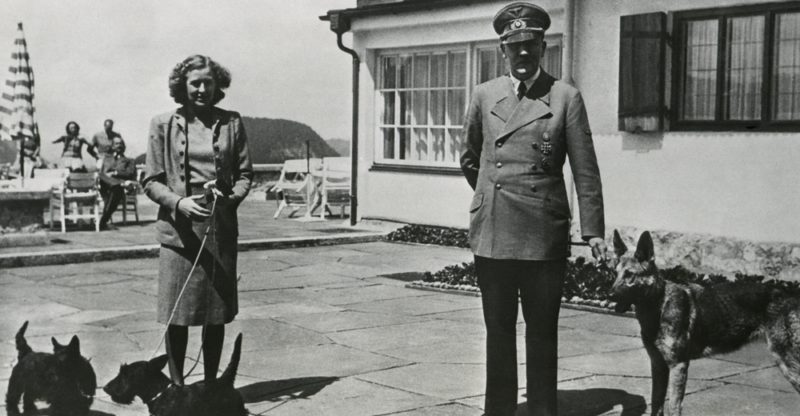
After several military blunders, in July 1944 Hitler survived an assassination attempt by German officers at his military headquarters in East Prussia. Colonel Claus von Stauffenberg and other military officers were immediately executed, and General Erwin Rommel, allegedly involved in the conspiracy, was forced to commit suicide.
As a consequence of the attack, Hitler suffered health problems. In January 1945, as Germany's defeat in the war became imminent, Hitler locked himself in his bunker in the Reich Chancellery in Berlin.
As Soviet troops entered Berlin, Hitler acknowledged the inevitability of defeat. On April 29, he married his lover, Eva Braun, and dictated his political testament, appointing Admiral Karl Dönitz head of state and Joseph Goebbels chancellor. Eventually, he committed suicide on April 30, 1945. A few days later, on May 7 and 8, 1945, the military authorities of the German Third Reich accepted unconditional surrender to the Allies.
Explore next:
References
- Kellerhoff, S. F. (2016). Mi lucha. La historia del libro que marcó el siglo XX. Crítica.
- Kershaw, I. (2019). Hitler. La biografía definitiva. Península.
- Lukacs, J. et al. (2023). Adolf Hitler. Encyclopedia Britannica. https://www.britannica.com/
Was this information useful to you?
Yes NoThank you for visiting us :)